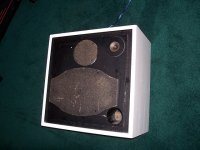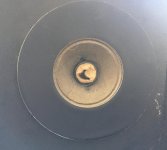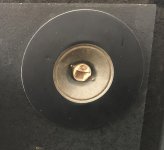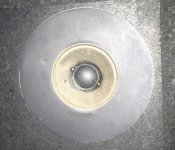hello all,
I have had a pair of JBL Aquarius 1s for the past twenty years or so which I have generally been happy with, however I have noticed that at a certain frequency-- around 4k I would guess-- there is a harsh metallic distortion.
Both speakers exhibit this problem.
1. I haven't replaced the crossover capacitors (they are encased in wax and I never trusted myself enough to break them up)
2. The domes were destroyed when I bought the speakers, really destroyed but I was assured that they were fine like that and it wouldn't affect the sound.
3. I tried replacing the amplifier recently to something with more power. It helped but the problem is still there and annoying!
I know the Le20 isn't meant to be the greatest speaker but overall they are nice to listen to at home. If replacing them is necessary, I might just repurpose the cabinet and the Le10a.
Thanks for any help!
I have had a pair of JBL Aquarius 1s for the past twenty years or so which I have generally been happy with, however I have noticed that at a certain frequency-- around 4k I would guess-- there is a harsh metallic distortion.
Both speakers exhibit this problem.
1. I haven't replaced the crossover capacitors (they are encased in wax and I never trusted myself enough to break them up)
2. The domes were destroyed when I bought the speakers, really destroyed but I was assured that they were fine like that and it wouldn't affect the sound.
3. I tried replacing the amplifier recently to something with more power. It helped but the problem is still there and annoying!
I know the Le20 isn't meant to be the greatest speaker but overall they are nice to listen to at home. If replacing them is necessary, I might just repurpose the cabinet and the Le10a.
Thanks for any help!
May I suggest that this was a false assurance? Replacement tweeters would appear to be in order.The domes were destroyed when I bought the speakers, really destroyed but I was assured that they were fine like that and it wouldn't affect the sound.
The specifications for the JBL S-105 Aquarius 1 are avalable here: JBL S 105 AQUARIUS I Service Manual — View online or Download repair manual
To be clear, the tweeter is an LE20-1 unit , nominally 8 ohm, which is filtered by a 3uF capacitor and level adjusted by a variable 8 ohm L PAD control.
Looking at the attachment, the tweeter appears to be a paper cone type and the following replacement from Monacor may be worth a try at minimum cost:
MONACOR: HT-22/8
To be clear, the tweeter is an LE20-1 unit , nominally 8 ohm, which is filtered by a 3uF capacitor and level adjusted by a variable 8 ohm L PAD control.
Looking at the attachment, the tweeter appears to be a paper cone type and the following replacement from Monacor may be worth a try at minimum cost:
MONACOR: HT-22/8
Attachments
It appears that the original Alnico magnet LE20-1 tweeter is much sought after and commands high second-hand prices.
Vintage JBL LE20 and LE25 tweeters
The only other thing worth trying is to replace the 3uF tweeter capacitor (use a modern 3.3uF polypropylene capacitor).
Vintage JBL LE20 and LE25 tweeters
The only other thing worth trying is to replace the 3uF tweeter capacitor (use a modern 3.3uF polypropylene capacitor).
Thank you for the replies...
I have seen a kit to replace the domes if that is indeed recommended.
The thing I don't understand is why the distortion happens in such a small frequency range. If the speakers are truly defective, I would imagine the distortion would occur across a broader range?
I will replace the crossover caps and see what I get as well.
I have seen a kit to replace the domes if that is indeed recommended.
The thing I don't understand is why the distortion happens in such a small frequency range. If the speakers are truly defective, I would imagine the distortion would occur across a broader range?
I will replace the crossover caps and see what I get as well.
A frequency scan would be required to determine the exact location of the troublesome metallic distortion.The thing I don't understand is why the distortion happens in such a small frequency range.
Troels' measurements indicate that the tweeter has a resonant peak around 1.6kHz and a reproduction peak at 10kHz. Either could give problems if unduly excited.
Photographs of the extent of the damage to the tweeter cones would be interesting!
Given the unusually high impedance peak (given how low the tweeter goes) I wonder if this doesn't need an impedance compensation network?
here is the condition of the two tweeters-- pretty bad!
I will test further today to see if I can find the exact frequency of distortion. To be honest, the distortion isn't egregious, just certain recordings of classical and female vocals can be particularly annoying!
Would replacement caps work? has anyone experience with them?
I will test further today to see if I can find the exact frequency of distortion. To be honest, the distortion isn't egregious, just certain recordings of classical and female vocals can be particularly annoying!
Would replacement caps work? has anyone experience with them?
Attachments
ok, so I did a frequency sweep and found that the worst problem is lower than I originally thought. With a sine wave, I can hear audible distortion around 1,8k.
This would suggest that the tweeters are not the problem but the midrange drivers as the crossover point is around 4k?
This would suggest that the tweeters are not the problem but the midrange drivers as the crossover point is around 4k?
Disconnect the tweeters, sweep again and you will know. 🙂
Distortion at a specific frequency can mean that something is rattling.
Distortion at a specific frequency can mean that something is rattling.
1. It's only the central dust cap that is damaged, the main tweeter cone looks intact. The dust cap could be repaired, perhaps with PVA adhesive and tissue paper.
2. The distortion may be occuring at the resonant frequency of the tweeter cone which is the region of 1.8kHz. This may be because of the simple series capacitor filter which doesn't adequately protect the tweeter from energy at this frequency.
A solution has been suggested by eriksquires and perhaps he will elaborate on it.
An alternative suggestion is to change the tweeter crossover fron 1st order (single capacitor) to 2nd order (capacitor and inductor) so as to better filter out the lower frequencies. I will come back with the component values if you wish to go down this route.
P.S. Worth first trying what TBL has suggested as it will reveal whether or not the midrange drivers are at fault - only you don't have to disconnect the tweeters, just turn the L PADs down to zero.
2. The distortion may be occuring at the resonant frequency of the tweeter cone which is the region of 1.8kHz. This may be because of the simple series capacitor filter which doesn't adequately protect the tweeter from energy at this frequency.
A solution has been suggested by eriksquires and perhaps he will elaborate on it.
An alternative suggestion is to change the tweeter crossover fron 1st order (single capacitor) to 2nd order (capacitor and inductor) so as to better filter out the lower frequencies. I will come back with the component values if you wish to go down this route.
P.S. Worth first trying what TBL has suggested as it will reveal whether or not the midrange drivers are at fault - only you don't have to disconnect the tweeters, just turn the L PADs down to zero.
1)The holes in the domes completely change speaker's parameters, the resonant frequency of the tweeter cone will no longer be what it was, so whatever value capacitor originally used won't be correct for the "modified" driver.1)here is the condition of the two tweeters-- pretty bad!
2)Would replacement caps work? has anyone experience with them?
2)Replacing crossover parts won't solve the lack of acoustical resistance the missing dome parts cause.
The damaged tweeter area could produce a "kazoo" like buzz excited by the woofer.
Replacing crossover parts in this situation is like buying a new wheel for a tire with a hole in it 😉
Cut out the damaged paper, vacuum out the debris, replace the dust cap.
Cheers,
Art
To avoid confusion, shzmm, the 'dome' you refer to is actually the 'dust cap', and it is this part that is damaged.
The major working part of this tweeter is the 'cone' which appears to be undamaged.
As Art says, the dust cap is easily replaced, see the link below for how this may be done:
How to replace a dust-cap
The major working part of this tweeter is the 'cone' which appears to be undamaged.
As Art says, the dust cap is easily replaced, see the link below for how this may be done:
How to replace a dust-cap
There's a huge trove of info about repairing the le20 over at LHF.
I posted a link within that thread that photo-documents a complete ( masterful I would say ) rebuild of a le14c ( along with the le20 ), all inside a JBL C53 Libra.
- That resource alone includes 133 pictures.
Here are the pics!
Here's the assembly that holds the le20 cone ( the cone-kit is glued to this assembly ).



One can see that repairing the dustcap is much easier if you dis-assemble the tweeter down to this point. ( Use a finger to reform the dustcap + use a small bit of glue or silicon sealer to fix any holes ).
The cone assembly mates to the magnetic assembly with a pair of locating pins ( removing most of the worry of re-assembly ).

The ornamental foilcal can be removed ( + saved ) with a very careful use of a heat gun ( paint-stripper ) and putty/spackling knife.
🙂
I posted a link within that thread that photo-documents a complete ( masterful I would say ) rebuild of a le14c ( along with the le20 ), all inside a JBL C53 Libra.
- That resource alone includes 133 pictures.
Here are the pics!
Here's the assembly that holds the le20 cone ( the cone-kit is glued to this assembly ).
One can see that repairing the dustcap is much easier if you dis-assemble the tweeter down to this point. ( Use a finger to reform the dustcap + use a small bit of glue or silicon sealer to fix any holes ).
The cone assembly mates to the magnetic assembly with a pair of locating pins ( removing most of the worry of re-assembly ).
The ornamental foilcal can be removed ( + saved ) with a very careful use of a heat gun ( paint-stripper ) and putty/spackling knife.
🙂
Last edited:
thank you for all the replies...
I will try to cut out the damaged caps first and then retest.
I have ordered replacement caps but these will take some time to arrive I imagine.
I will try to cut out the damaged caps first and then retest.
I have ordered replacement caps but these will take some time to arrive I imagine.
Last edited:
Valuable information, EarlK!
This speaker range is new to me and I love learning about vintage speakers like this. 😎
@ shzmm. By 'replacement domes', I hope you mean 'replacement dust caps'.
Hopefully their replacement will be the answer to your problem. Please let us know how it goes, even though that may be some time away.
EDIT: Thanks for your edit from domes to caps!
This speaker range is new to me and I love learning about vintage speakers like this. 😎
@ shzmm. By 'replacement domes', I hope you mean 'replacement dust caps'.
Hopefully their replacement will be the answer to your problem. Please let us know how it goes, even though that may be some time away.
EDIT: Thanks for your edit from domes to caps!
Last edited:
Thanks again for all the help here...
I have replaced the dust caps on both speakers, the new ones fit pretty well. My tweeters were easy enough to just slice out the old paper and clean out so I didn't remove them in the end.
At the same time, I recapped the crossovers which makes them sound much more lively. I can finally listen to my Nina Simone records again without distortion! Piano and female vocals were intolerable.
I have replaced the dust caps on both speakers, the new ones fit pretty well. My tweeters were easy enough to just slice out the old paper and clean out so I didn't remove them in the end.
At the same time, I recapped the crossovers which makes them sound much more lively. I can finally listen to my Nina Simone records again without distortion! Piano and female vocals were intolerable.
Attachments
- Home
- Loudspeakers
- Multi-Way
- Tweeters distorting at specific frequency




